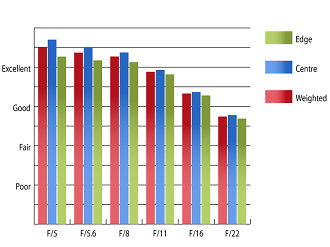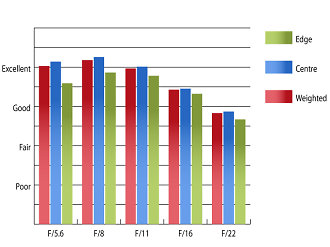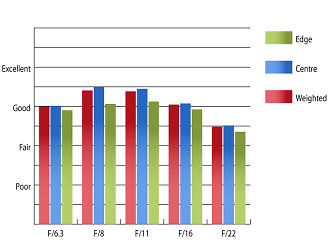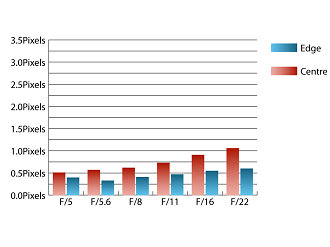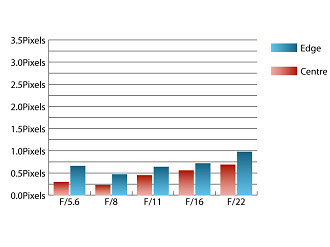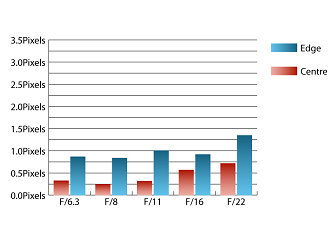Sigma 150-600mm f/5-6.3 DG OS HSM C Review
Sigma 150-600mm f/5-6.3 DG OS HSM C Performance
At 150mm, sharpness already approaches outstanding levels in the centre of the frame at maximum aperture and the clarity achieved towards the edges of the frame is excellent. There is no benefit to image quality with stopping down, unless it is a creative decision.
Zooming to 300mm results in excellent sharpness in the centre of the frame with very good sharpness towards the edges at maximum aperture. Peak performance is at f/8, where sharpness is excellent in the centre, and not too far behind towards the edges of the frame.
Finally, at 600mm, sharpness in the centre of the frame at maximum aperture is good, and not far behind towards the edges of the frame. Stopping down to between f/8 and f/11 results in peak performance for this focal length, with the lens producing very good sharpness in the centre and good sharpness towards the edges at this focal length.
How to read our charts
The blue column represents readings from the centre of the picture frame at the various apertures and the green is from the edges. Averaging them out gives the red weighted column.The scale on the left side is an indication of actual image resolution. The taller the column, the better the lens performance. Simple.
For this review, the lens was tested on a Canon EOS 5D Mark III using Imatest.
Chromatic aberrations are well enough controlled for a super-telephoto zoom lens with fringing only exceeding one pixel width at f/22 throughout the zoom range. This extremely low level of CA should pose few issues, even in large prints, or harsh crops from the edges of the frame.
How to read our charts
Chromatic aberration is the lens' inability to focus on the sensor or film all colours of visible light at the same point. Severe chromatic aberration gives a noticeable fringing or a halo effect around sharp edges within the picture. It can be cured in software.Apochromatic lenses have special lens elements (aspheric, extra-low dispersion etc) to minimize the problem, hence they usually cost more.
For this review, the lens was tested on a Canon EOS 5D Mark III using Imatest.
Falloff of illumination towards the corners is typical for a telephoto lens with a moderate maximum aperture. The corners are 1.62 stops darker than the centre at maximum aperture at 150mm and 1.51 stops darker at 600mm. Visually uniform illumination is achieved by f/8 at 150mm and f/11 at 600mm.
Pincushion distortion is present throughout the zoom range. At 150mm there is 1.82% pincushion distortion, which decreases to 1.01% at 600mm, which shouldn't cause issues in normal use. If absolutely straight lines are paramount, then you'll be glad to hear that the distortion pattern is uniform across the frame, which should make applying corrections in image editing software fairly straightforward.
A deep, circular hood is supplied as standard with the lens, which does a great job of protecting the lens from extraneous light that may cause unwanted flare and loss of contrast. During testing there were no issues with flare and contrast holds up well, even when shooting into the light.
Value For Money
Priced at around £900, this 150-600mm lens from Sigma appears to offer excellent value for money when compared to other lenses offering a similar field of view. Although this lens lacks the dust and moisture resistance of its more expensive Sports series equivalent, it is around £600 less expensive, so it may be worth it to you, if you can live with the slight compromise.
Another way to get a 600mm equivalent, but with a slightly faster maximum aperture would be to use Sigma's 120-300mm f/2.8 lens, which costs around £1940, with Sigma's TC-2001 teleconverter, which costs around £300. This combination will provide you with 600mm f/5.6, and the benefit of f/2.8 maximum aperture through the 120-300mm range without the converter.
Canon's 200-400mm f/4 L IS USM includes its own built-in 1.4x teleconverter, providing a maximum telephoto reach equivalent to a 560mm f/5.6 lens. Unfortunately, this lens costs around £8310, which is beyond the reach of most people.
Nikon's 200-400mm f/4 can be picked up for around £4890, which can be used with their TC-14e III teleconverter, which costs around £310.
Tamron offers the 150-600mm f/5-6.3 Di VC USD lens for around £900, or if your budget is more limited, the 200-500mm Di f/5-6.3 lens costs around £730, but gives up 100mm at the long end, lacks stabilisation and silent focusing.
Add your message
Please login here or if you've not registered, you can register here. Registering is safe, quick and free.
photodo Stats
428 MTF tests
74 in-depth photodo reviews
100+ users join each day
Help the lens community by reviewing or rating a lens today via our lens search
Latest Lens Reviews
- Chinon 28mm f/2.8 Vintage Lens Review
- Canon EF 70-200mm f/4L IS II USM Lens Review
- Samyang AF 85mm f/1.4 EF Review
- Sigma 70mm f/2.8 DG Macro Art Review
- Samyang AF 24mm f/2.8 FE Review
- Meike 50mm f/1.7 Review
- Tamron 70-210mm f/4 Di VC USD Review
- Lensbaby Burnside 35mm f/2.8 Review
- Asahi Super Takumar 50mm f/1.4 Review
- Asahi Super-Multi-Coated Takumar 135mm f/3.5 Review
